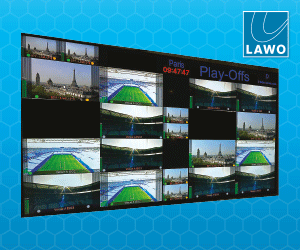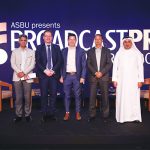Nick Grande, Managing Director of ChannelSculptor, who moderated this panel discussion, summed it up for BroadcastPro ME This years CEO panel had the distinction that all the panelists despite coming from very different organisations and perspectives, seemed to agree not only on the factors undermining sustainable business models for television in the Middle East, but also […]

Nick Grande, Managing Director of ChannelSculptor, who moderated this panel discussion, summed it up for BroadcastPro ME
This years CEO panel had the distinction that all the panelists despite coming from very different organisations and perspectives, seemed to agree not only on the factors undermining sustainable business models for television in the Middle East, but also on how these issues should be addressed.
Transparency and Industry Cooperation
People meters have been the hot topic of 2012, and as expected, audience measurement received top billing on the panel. As Peter Einstein, Deputy CEO of Rotana Media Group put it: we have been operating like we were in the grand souq the market has lacked a proper basis for a cost per thousand and advertisers have been getting the best deal on the planet.
Now the industry needs to come together and pay a fair price for what is actually being delivered.
Mohamed Al Shahi, CEO of Strategy, Technology and Executive Affairs at DMI called for proper audience measurement. He pointed out that not only would this increase the advertising pie, it would also give broadcasters a better understanding of what their audiences want, and would help them make their programming more relevant and attractive.
Chris OHearn, CEO of tView, the UAEs new audience measurement service, asked the panel why there are still no television industry bodies in the region managing regulation and cooperation within the industry, and where will the impetus for this come from?
Dr Riyadh Najm, Deputy Minister of Information Affairs at Saudi Ministry of Culture & Information, believes that government intervention is essential to start this process. He observed that currently some parts of the industry are benefitting at the expense of others .the middle people are able to bring different pictures to different players, capitalising on this and making healthy margins.
The only entity that would be able to correct this would be [government through] the introduction of regulations. He hinted that the government of Saudi Arabia could be announcing its own audience measurement initiative as early as December 2012.
All of the panellists highlighted the need for industry bodies that can aid cooperation and transparency in a market that has been starved of trustworthy audience data. DMIs Mohamed Al Shahi received a round of applause from the panel and the audience when he said Advertising Agencies should buy in and trust the people meters.
With so much harmony between broadcasters and regulators, it seems inevitable that transparent audience measurement tools will be commonplace in the region before too long.
Localisation of Channels and Content
Considering the panel consisted almost entirely of CEOs working in pan-regional broadcasting, it may come as a surprise that all of them highlighted the importance of localisation of channels and content, and the development of domestic markets.
Dr Riyadh blamed the inaction of governments and regulators during the development of digital television services for the demise of local terrestrial television in the region, and the rise to dominance of a one size fits all pan regional TV. He spoke passionately about the commercial and cultural opportunity that local broadcasting represents.
If a television channel focuses on a single country, or even just a single city, it can be far more tailored to its audience. This, in turn, makes it more relevant and attractive for advertisers seeking to reach that audience. Finally, since the audience is small and geographically contained, the cost of premium content rights to the channel can be far lower, because the same rights can be sold to other local broadcasters covering different audiences.
Nart Bouran, Head of Sky News Arabia, noted that this evolution is already taking place naturally within the market. Advertising sales in Egypt, Libya, Tunisia and Syria may be suffering in the short term, but these are becoming far more localised TV markets. New broadcasters coming into the market have to be positive look at this long term, and anticipate the changes that are going to happen over the next few years.
Making Pay-TV work
Mohamed Youssif, CEO of YahLive, said he sees pay-TV as fundamental to the satellite platform his company has launched. He called for a reinvention of pay-TV in the region, pointing out that the real opportunity is in much lower value transactions.
With an audience of 50 million TV households to reach, transaction values as low as 10 cents can turn into significant revenue streams.
Nart Bouran echoed this view, highlighting the huge level of piracy in the region as a great indication of demand for premium content. All that is required is the right (low) price point.
There was some debate over the willingness of Middle East consumers to pay for TV, but as Peter Einstein noted, all TV is pay-TV in the sense that the consumer must buy a dish and a set top box. Content can be a small increment to that cost, and could be an impulse purchase decision rather than a monthly commitment. Television can learn from the mistakes made by the music industry during the 10 years it took for it to embrace low-value online transactions.
Youssif also highlighted the importance of genuine differentiation of premium content. High Definition TV is his personal passion: HD channels are carried in 10 MB or more in every mainstream television market around the world, and yet, in the MENA region, channels routinely limit their bandwidth to 6 MB.
The Long View
The most uplifting thing for me about this years CEO panel was the optimism and desire for cooperation shared by the panellists. As Nart Bouran put it the system is fixing itself we just have to be patient to see the results of these changes. As we walked off the stage, I had the feeling that the conversation would continue, and that we might see the fruits of this spirit of collaboration before next years BroadcastPro ME summit.
















































































